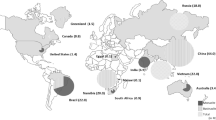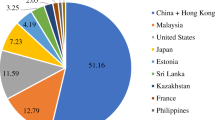Abstract
Currently, the process of extracting rubidium from ores has attracted a great deal of attention due to the increasing application of rubidium in high-technology field. A novel process for the comprehensive utilization of rubidium ore resources is proposed in this paper. The process consists mainly of mineral dissociation, selective leaching, and desilication. The results showed that the stable silicon—oxygen tetrahedral structure of the rubidium ore was completely disrupted by thermal activation and the mineral was completely dissociated, which was conducive to subsequent selective leaching. Under the optimal conditions, extractions of 98.67% Rb and 96.23% K were obtained by leaching the rubidium ore. Moreover, the addition of a certain amount of activated Al(OH)3 during leaching can effectively inhibit the leaching of silicon. In the meantime, the leach residue was sodalite, which was successfully synthesized to zeolite A by hydrothermal conversion. The proposed process provided a feasible strategy for the green extraction of rubidium and the sustainable utilization of various resources.
Similar content being viewed by others
References
L.O. Quarrie, The effects of atomic rubidium vapor on the performance of optical windows in diode pumped alkali lasers (DPALs), Opt. Mater., 35(2013), No. 5, p. 843.
S.S. Losev, D.I. Sevostianov, V.V. Vassiliev, and V.L. Velishansky, Production of miniature glass cells with rubidium for chip scale atomic clock, Phys. Procedia, 71(2015), p. 242.
P.C. Harikesh, H.K. Mulmudi, B. Ghosh, et al., Rb as an alternative cation for templating inorganic lead-free perovskites for solution processed photovoltaics, Chem. Mater., 28(2016), No. 20, p. 7496.
S. Wang, R.X. Ma, C.Y. Wang, S.N. Li, and H. Wang, Incorporation of Rb cations into Cu2FeSnS4 thin films improves structure and morphology, Mater. Lett., 202(2017), p. 36.
M. Saliba, T. Matsui, K. Domanski, et al., Incorporation of rubidium cations into perovskite solar cells improves photovoltaic performance, Science, 354(2016), No. 6309, p. 206.
L.F. Wang, M.M. Geng, X.N. Ding, et al., Research progress of the electrochemical impedance technique applied to the high-capacity lithium-ion battery, Int. J. Miner. Metall. Mater., 28(2021), No. 4, p. 538.
N. Vieceli, C.A. Nogueira, M.F.C. Pereira, et al., Effects of mechanical activation on lithium extraction from a lepidolite ore concentrate, Miner. Eng., 102(2017), p. 1.
H. Guo, G. Kuang, J.X. Yang, and S. Hu, Fundamental research on a new process to remove Al3+ as potassium alum during lithium extraction from lepidolite, Metall. Mater. Trans. B, 47(2016), No. 6, p. 3557.
Z.Q. Shan, X.Q. Shu, J.F. Feng, and W.N. Zhou, Modified calcination conditions of rare alkali metal Rb-containing muscovite (KAl2[AlSi3O10](OH)2), Rare Met., 32(2013), No. 6, p. 632.
M.R. Tavakoli Mohammadi, S.M. Javad Koleini, S. Javanshir, H. Abolghasemi, and M. Abdollahy, Extraction of rubidium from gold waste: Process optimization, Hydrometallurgy, 151(2015), p. 25.
X.H. Guo, M.P. Zheng, X.F. Liu, Z. Nie, and L. Pu, Saline cesium resource and prospect of its exploitation and utilization in Tibet, J. Salt. Chem. Ind., 37(2008), p. 24.
T. Nur, G. Naidu, P. Loganathan, J. Kandasamy, and S. Vigneswaran, Rubidium recovery using potassium cobalt hexacyanoferrate sorbent, Desalin. Water Treat., 57(2016), No. 55, p. 26577.
Y.S. Liao and D.J. Yang, Application status of rubidium resource and research situation of its extraction technology, Yunnan Metall., 41(2012), No. 4, p. 27.
G. Naidu, P. Loganathan, S. Jeong, et al., Rubidium extraction using an organic polymer encapsulated potassium copper hexacyanoferrate sorbent, Chem. Eng. J., 306(2016), p. 31.
M.S. Safarzadeh, M.S. Moats, and J.D. Miller, Acid bake-leach process for the treatment of enargite concentrates, Hydrometallurgy, 119–120(2012), p. 30.
P. Meshram, Abhilash, B.D. Pandey, T.R. Mankhand, and H. Deveci, Acid baking of spent lithium ion batteries for selective recovery of major metals: A two-step process, J. Ind. Eng. Chem., 43(2016), p. 117.
S.L. Zheng, P. Li, L. Tian, et al., A chlorination roasting process to extract rubidium from distinctive Kaolin ore with alternative chlorinating reagent, Int. J. Miner. Process., 157(2016), p. 21.
Q.X. Yan, X.H. Li, Z.X. Wang, et al., Extraction of lithium from lepidolite by sulfation roasting and water leaching, Int. J. Miner. Process., 110–111(2012), p. 1.
C. Yang, J.L. Zhang, Q.K. Jing, Y.B. Liu, Y.Q. Chen, and C.Y. Wang, Recovery and regeneration of LiFePO4 from spent lithium-ion batteries via a novel pretreatment process, Int. J. Miner. Metall. Mater., 28(2021), No. 9, p. 1478.
P. Xing, C.Y. Wang, B.Z. Ma, L. Wang, W.J. Zhang, and Y.Q. Chen, Rubidium and potassium extraction from granitic rubidium ore: Process optimization and mechanism study, ACS Sustainable Chem. Eng., 6(2018), No. 4, p. 4922.
Q. Zeng, S.Z. Li, W. Sun, L. Hu, H. Zhong, and Z.G. He, Eco-friendly leaching of rubidium from biotite-containing minerals with oxalic acid and effective removal of Hg2+ from aqueous solution using the leaching residues, J. Cleaner Prod., 306(2021), art. No. 127167.
H. Xu and J.S.J. van Deventer, The effect of alkali metals on the formation of geopolymeric gels from alkali-feldspars, Colloids Surf. A, 216(2003), No. 1–3, p. 27.
B.E. Kalinowski and P. Schweda, Kinetics of muscovite, phlogopite, and biotite dissolution and alteration at pH 1–4, room temperature, Geochim. Cosmochim. Acta, 60(1996), No. 3, p. 367.
D. Ciceri, M. de Oliveira, R.M. Stokes, T. Skorina, and A. Allanore, Characterization of potassium agrominerals: Correlations between petrographic features, comminution and leaching of ultrapotassic syenites, Miner. Eng., 102(2017), p. 42.
K.H. Park, H.I. Kim, P.K. Parhi, et al., Extraction of metals from Mo-Ni/Al2O3 spent catalyst using H2SO4 baking-leaching-solvent extraction technique, J. Ind. Eng. Chem., 18(2012), No. 6, p. 2036.
Y.M. Chen, N.N. Liu, L.G. Ye, S. Xiong, and S.H. Yang, A cleaning process for the removal and stabilisation of arsenic from arsenic-rich lead anode slime, J. Cleaner Prod., 176(2018), p. 26.
Z. Luo, J. Yang, H.W. Ma, M.T. Liu, and X. Ma, Recovery of magnesium and potassium from biotite by sulfuric acid leaching and alkali precipitation with ammonia, Hydrometallurgy, 157(2015), p. 188.
N. Harouiya and E.H. Oelkers, An experimental study of the effect of aqueous fluoride on quartz and alkali-feldspar dissolution rates, Chem. Geol., 205(2004), No. 1–2, p. 155.
S. Nisan, F. Laffore, C. Poletiko, and N. Simon, Extraction of rubidium from the concentrated brine rejected by integrated nuclear desalination systems, Desalin. Water Treat., 8(2009), No. 1–3, p. 236.
Q. Zeng, L.M. Huang, D.X. Ouyang, Y.H. Hu, H. Zhong, and Z.G. He, Process optimization on the extraction of rubidium from rubidium-bearing biotite, Miner. Eng., 137(2019), p. 87.
Y.W. Lv, P. Xing, B.Z. Ma, et al., Efficient extraction of lithium and rubidium from polylithionite via alkaline leaching combined with solvent extraction and precipitation, ACS Sustainable Chem. Eng., 8(2020), No. 38, p. 14462.
P. Xing, C.Y. Wang, L. Zeng, et al., Lithium extraction and hydroxysodalite zeolite synthesis by hydrothermal conversion of α-spodumene, ACS Sustainable Chem. Eng., 7(2019), No. 10, p. 9498.
G. Martin, C. Pätzold, and M. Bertau, Integrated process for lithium recovery from zinnwaldite, Int. J. Miner. Process., 160(2017), p. 8.
X. Ma, J. Yang, H.W. Ma, and C.J. Liu, Hydrothermal extraction of potassium from potassic quartz syenite and preparation of aluminum hydroxide, Int. J. Miner. Process., 147(2016), p. 10.
Z.Q. Zhang and R.Z. Yuan, Study on dehydroxylation process of kaolinite and its structural change, Bull. Chin. Ceram. Soc., 1993, No. 6, p. 37.
S.Q. Su, H.W. Ma, and X.Y. Chuan, Hydrothermal decomposition of K-feldspar in KOH-NaOH-H2O medium, Hydrometallurgy, 156(2015), p. 47.
M.K. Naskar, D. Kundu, and M. Chatterjee, Effect of process parameters on surfactant-based synthesis of hydroxy sodalite particles, Mater. Lett., 65(2011), No. 3, p. 436.
N.N. Xue, Y.M. Zhang, T. Liu, J. Huang, and Q.S. Zheng, Effects of hydration and hardening of calcium sulfate on muscovite dissolution during pressure acid leaching of black shale, J. Cleaner Prod., 149(2017), p. 989.
N. Vieceli, F.O. Durão, C. Guimarães, C.A. Nogueira, M.F.C. Pereira, and F. Margarido, Kinetic approach to the study of froth flotation applied to a lepidolite ore, Int. J. Miner. Metall. Mater., 23(2016), No. 7, p. 731.
H. Li, J. Eksteen, and G. Kuang, Recovery of lithium from mineral resources: State-of-the-art and perspectives — A review, Hydrometallurgy, 189(2019), art. No. 105129.
P. Xing, C.Y. Wang, L. Wang, B.Z. Ma, Y.Q. Chen, and G.D. Wang, Clean and efficient process for the extraction of rubidium from granitic rubidium ore, J. Cleaner Prod., 196(2018), p. 64.
L.M. Zeng and Z.B. Li, Solubility and modeling of sodium aluminosilicate in NaOH-NaAl(OH)4 solutions and its application to desilication, Ind. Eng. Chem. Res., 51(2012), No. 46, p. 15193.
L.N. Shi, S. Ruan, J. Li, and A.R. Gerson, Desilication of low alumina to caustic liquor seeded with sodalite or cancrinite, Hydrometallurgy, 170(2017), p. 5.
X.D. Liu, Y.P. Wang, X.M. Cui, Y. He, and J. Mao, Influence of synthesis parameters on NaA zeolite crystals, Powder Technol., 243(2013), p. 184.
P. Xing, C.Y. Wang, B.Z. Ma, and Y.Q. Chen, Removal of Pb(II) from aqueous solution using a new zeolite-type absorbent: Potassium ore leaching residue, J. Environ. Chem. Eng., 6(2018), No. 6, p. 7138.
L.L. Bai, K.X. Li, Y.B. Yan, X.L. Jia, J.M. Lee, and Y.H. Yang, Catalytic epoxidation of cis-cyclooctene over vanadium-exchanged faujasite zeolite catalyst with ionic liquid as cosolvent, ACS Sustainable Chem. Eng., 4(2016), No. 2, p. 437.
H. Jin, J.L. Zhang, D.D. Wang, Q.K. Jing, Y.Q. Chen, and C.Y. Wang, Facile and efficient recovery of lithium from spent LiFePO4 batteries via air oxidation-water leaching at room temperature, Green Chem., 24(2022), No. 1, p. 152.
D. Hu, B.Z. Ma, X. Li, et al., Efficient separation and recovery of gallium and indium in spent CIGS materials, Sep. Purif. Technol., 282(2022), art. No. 120087.
Acknowledgements
This work was financially supported by the National Natural Science Foundation of China (Nos. U1802253 and 52034002), and the Fundamental Research Funds for the Central Universities, China (No. FRF-TT-19-001).
Author information
Authors and Affiliations
Corresponding authors
Additional information
Conflict of Interest
The authors declare that they have no known competing financial interests or personal relationships that could have appeared to influence the work reported in this paper.
Supplementary Information
12613_2022_2436_MOESM1_ESM.docx
Comprehensive utilization of complex rubidium ore resources: Mineral dissociation and selective leaching of rubidium and potassium
Rights and permissions
About this article
Cite this article
Zhang, Q., Ma, B., Wang, C. et al. Comprehensive utilization of complex rubidium ore resources: Mineral dissociation and selective leaching of rubidium and potassium. Int J Miner Metall Mater 30, 857–867 (2023). https://doi.org/10.1007/s12613-022-2436-1
Received:
Revised:
Accepted:
Published:
Issue Date:
DOI: https://doi.org/10.1007/s12613-022-2436-1




